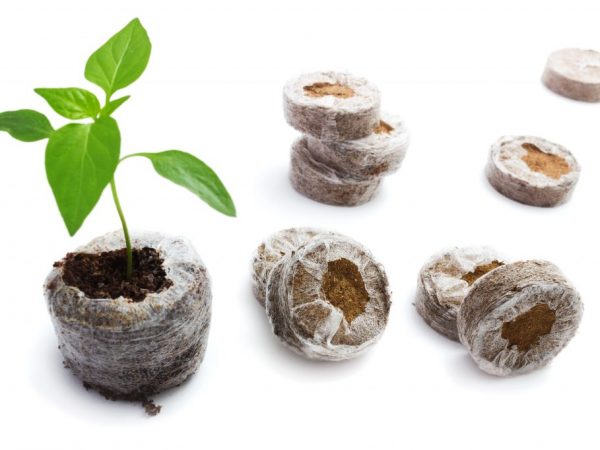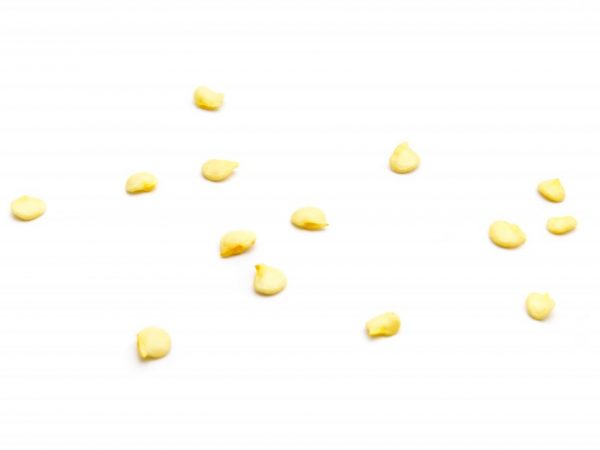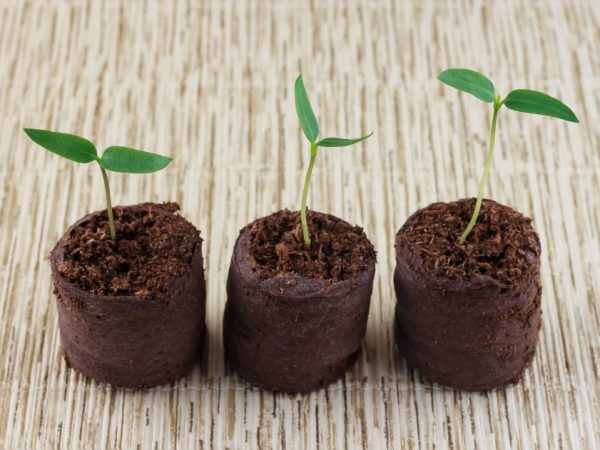Growing pepper in peat tablets
Bell peppers require special care. Growing pepper in peat tablets is a convenient and easy way to avoid picking.

Growing pepper in peat tablets
Selection of peat tablets
A peat tablet is a small washer, about 2–7 cm in diameter. The material is pressed peat or coconut fiber. The substrate already contains all the trace elements necessary for planting, antibacterial and nutrients. When buying peat tablets, you need to pay attention to the presence of a special grid: without it, the form will not hold, or you can find a special glass or box for the peat. The mesh is located around the entire perimeter, except for the top for landing.
For growing seedlings of peppers in peat tablets, a pressed medium-sized substrate, 3-4 cm in diameter, is selected. You can buy it both individually and in boxes. The latter is more convenient, since the box is useful for disembarkation. A cover is required. It is important to choose peat with low acidity in the composition. Pepper is a whimsical plant and does not accept other soil.
When choosing a substrate, you should give preference to materials that are sold in packaging. It is also necessary to read the composition to be sure of this planting material.
Benefits of peat tablets
This method of growing pepper has many advantages. These include:
- loose soil, ideal for air and moisture;
- peat, which has all the necessary vitamins and fertilizers for pepper;
- suitable indicators of soil acidity (6-6.5 pH);
- protection from diseases and pests;
- ease of use (for each plant individually);
- does not harm the root system.
Seed planting time
The optimal dates for planting seedlings are in February and early March, but you can plant peppers in peat tablets a little later - in the second half of March or early April. Thanks to the perfectly matched composition of the soil in the tablet, the plant will grow faster and have time to ripen for planting in open ground.
Seed preparation

Seeds should be prepared for planting
Prepare pepper seeds for planting in the same way as when growing seedlings in the usual way. You must first make sure they are good. It is recommended to immerse the seeds in water for a few minutes. If the grains have risen to the surface, they will not yield a crop. You can work with the seeds that remain at the bottom. The rest are pickled in a weak solution of potassium permanganate (20-30 min.). After the seed should be rinsed under running water. Next, the grains are placed in a saucer or plate, after laying a piece of gauze moistened with water. Be sure to ensure that the moisture does not evaporate, keep warm at a temperature of 25-27 ° C for about 6-7 days. When the seeds hatch, they are planted in prepared soil.
You can plant pepper grains without germination, but then some of them will not sprout. In this case, several seeds are planted in the tablet, and when they germinate, the weakest are removed.Do not pull them out by the root: this way you can easily damage a neighboring sprout. It is recommended to carefully cut the seedling with scissors at the very base.
Planting seeds
Before planting seeds, you should prepare all the necessary materials. For planting you need:
- Peat tablets. They are prepared and placed in a plastic container, preferably with a transparent lid or film.
- Swollen pepper seeds. They are pre-treated with growth stimulants.
- Thin skewer and soil trowel. They are needed for the convenience of working with peat soil.
- Warm water. It is used for watering and swelling tablets.
- Tweezers. It makes it easier to plant a sprouted seed.
The tablets are laid out in the tray as close to each other as possible, since the finished substrate is not entirely stable. They are watered with lukewarm water. After 15 minutes. peat should increase its volumes several times. If the tablet has not increased, add more water. After that, the excess liquid is drained.
There is a small depression in the upper part of the peat product. Use a skewer to make a hole of 1-1.5 cm. Carefully, so as not to damage the hatched sprouts, use tweezers to transfer the seed to the prepared soil. From above, the seeds are covered with a nutritious soil mixture, lightly tamped. The tray is covered with a transparent lid or foil and transferred to a warm place with a temperature of 25-28 ° C. Be sure to make sure that the soil does not dry out, water it on time. If condensation has accumulated under the lid or film, ventilate a little to prevent mold from appearing on the soil and rotting of sprouts. Once a day, open the lid of the tray for a few minutes.
Seedling care

Provide seedlings with good care
After 7-10 days, the first leaves should appear. During this period, the plant should not be poured. It is enough to sprinkle them with water from a spray bottle. For the next 3-4 days, it is advisable to lower the temperature to 17 ° C, and then transfer the seedlings to a brighter and warmer place (24-25 ° C). At night, the temperature should not be higher than 15 ° C, but not lower than 12 ° C, otherwise the plant will die. Changes in temperature during the day and at night are needed to harden the seedlings: in this way they are prepared for transplanting into open ground.
Seedling care rules:
- you do not need to feed the plant: the tablets contain all the vitamins and microelements necessary for growth;
- seedlings develop quickly enough without additional stimulants;
- watering the sprouts should be infrequent;
- it is important to monitor the condition of the peat: if it has decreased in size, simply pour water into the tray;
- excess moisture is urgently removed, since stagnant water prevents the roots from breathing;
- water for irrigation is taken settled and not cold;
- on a cloudy day, it is advisable to use the illumination of a special lamp.
Transfer
If the roots of the seedlings have grown so much that they began to break through the mesh, this is a clear sign that it is time to transplant the plant into a larger container. For this, flower pots are quite suitable. By that time, the seedlings produce 3-4 pairs of true leaves.
You can buy soil for transplanting seedlings in a special store, you just have to pay attention to the composition indicated on the package, and also prepare the mixture with your own hands.
To do this, take humus, peat, turf or garden soil in equal proportions, add a little washed coarse sand. For 5 liters of the finished soil composition, take 1 tbsp. l. mineral fertilizer and 0.5 tbsp. wood ash. Stir.
The pots must have a drainage hole so that excess moisture does not stagnate. The container size is also taken into account. Roomy dishes are recommended, since pepper roots love to grow, they need freedom.
A mixture of 3-4 cm is poured into a prepared pot. A peat tablet is placed on top, having previously cut or completely removed the mesh. After that, it is well covered with soil and lightly tamped. The plant is watered immediately.
It is not recommended to use transparent containers for planting: the development of roots and plants will drastically slow down.
Landing in the ground
They start planting in open ground when the plant has already given 8 true leaves. Carefully observe the crops, periodically turning the pots towards and away from the sun. If you plan to grow pepper seedlings in a greenhouse, you can do without planting in pots. Further, the plants are looked after as usual.
Conclusion
Growing seedlings in peat tablets for peppers gives an excellent result: strong healthy roots and stems of the plant. Taken together, this produces a high quality crop.


